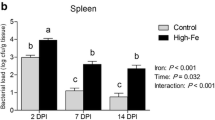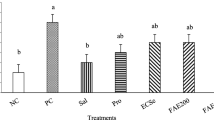Abstract
Two-wk-old broiler chicks were inoculated via crop intubation withEimeria acervulina at two doses: 105 or 106 sporulated oocysts/bird or withEimeria tenella at a dose of 105 sporulated oocysts/bird. Serum and liver samples were collected on days 3 and 6 post-inoculation (PI). There were no significant changes in serum or liver zinc, copper, and iron concentrations in any of the infected groups by 3 d PI. However, on d 6, PI serum protein was significantly reduced in all of the infected groups compared to their pair-fed controls. The chicks infected withE. tennella had significantly reduced serum zinc (1.20 vs 1.77 μg/mL) and iron (0.44 vs 1.28 μg/mL) concentrations and significantly elevated serum copper (0.28 vs 0.17 μg/mL) and ceruloplasmin levels (20.33 vs 11.11 μg/mL) compared to their pair-fed counterparts. Those chicks infected withE. acervulina (106 oocysts/bird) exhibited significantly reduced serum iron concentration by 6 days PI (0.90 vs 1.14 μg/mL). Liver zinc was significantly increased in the chicks infected withE. tenella (349 vs 113 μg/g dry liver wt), as was copper (24 vs 19 μg/g), whereas liver iron concentration was significantly reduced (172 vs 243 μg/g) compared to pair-fed controls. At both dose levels, the chicks infected withE. acervulina exhibited a significant reduction in liver iron by 6 d PI. Hepatic cytosol metals generally reflected whole tissue levels. Metallothionein (MT)-bound zinc was significantly elevated in the chicks infected withE. tenella. Iron bound to a high molecular weight, heat-stable protein fraction (presumably cytoplasmic ferritin) was significantly reduced in chicks infected withE. acervulina, as well as those infected withE. tenella. Collectively, the changes in serum zinc, copper, and iron concentrations, as well as the changes in hepatic zinc and MT-zinc concentrations in the chicks infected withE. tenella were similar to changes evoked during an acute phase response to infection. It is possible that a secondary bacterial infection or inflammation stemming from erosion of the lining of the cecum may play a role in the response of trace element metabolism to theE. tenella infection.
Similar content being viewed by others
References
P. L. Long,Br. Poult. Sci. 25, 3 (1984).
L. L. Southern and D. H. Baker,J. Nutr. 113, 688 (1983).
L. L. Southern and D. H. Baker,J. Anim. Sci. 54, 989 (1982).
L. L. Southern and D. H. Baker,J. Nutr. 112, 2353 (1982).
L. L. Southern and D. H. Baker,Poult. Sci. 62, 401 (1983).
D. E. Turk,Fed. Proc. 33, 106 (1974).
D. E. Turk,Poult. Sci. 60, 323 (1981).
D. E. Turk,Poult. Sci. 65, 2098 (1986).
W. R. Beisel,Am. J. Clin. Nutr. 30, 1236 (1977).
E. J. Butler, M. J. Curtis, and M. Walford,Res. Vet. Sci. 15, 267 (1973).
E. J. Butler and M. J. Curtis,Res. Vet. Sci. 15, 363 (1973).
D. W. T. Piercy,J. Comp. Pathol. 89, 309 (1979).
M. J. Curtis and E. J. Butler,Res. Vet. Sci. 28, 217 (1980).
C. A. Bolin,Am. J. Vet. Res. 47, 1813 (1986).
K. C. Klasing,Am. J. Physiol. 247, R901 (1984).
K. C. Klasing, M. P. Richards, S. E. Darcey, and D. E. Laurin,Proc. Soc. Exptl. Biol. Med. 184, 7 (1987).
R. F. Kampschmidt, H. F. Upchurch, C. L. Eddington, and L. Pulliam,Am. J. Physiol. 224, 530 (1973).
C. A. Dinarello,Rev. Infect. Dis. 6, 51 (1984).
R. A. DiSilvestro and R. J. Cousins,Life Sci. 35, 2113 (1984).
M. Karin, R. J. Imbra, A. Heguy, and G. Wong,Molec. Cell. Biol. 5, 2806 (1985).
E. W. Rice,Anal. Biochem. 3, 452 (1962).
SAS Institute.SAS User’s Guide, J. T. Helwig and K. A. Council, eds., SAS Institute, Raleigh, NC, 1979.
G. S. McKnight, D. C. Lee, D. Hemmaplardh, C. A. Finch, and R. D. Palmiter,J. Biol. Chem. 255, 144 (1980).
M. P. Richards, R. W. Rosebrough, and N. C. Steele,J. Nutr. 117, 481 (1987).
J. F. Stephens and O. H. Vestal,Poult. Sci. 45, 446 (1966).
Author information
Authors and Affiliations
Additional information
Mentions of a trademarkr, proprietary product or specific equipment does not consitute a guarantee or warranty by the US Department of Agriculture and does not imply its approval to the exclusion of other products.
Rights and permissions
About this article
Cite this article
Richards, M.P., Augustine, P.C. Serum and liver zinc, copper, and iron in chicks infected withEimeria acervulina orEimeria tenella . Biol Trace Elem Res 17, 207–219 (1988). https://doi.org/10.1007/BF02795457
Received:
Accepted:
Issue Date:
DOI: https://doi.org/10.1007/BF02795457




